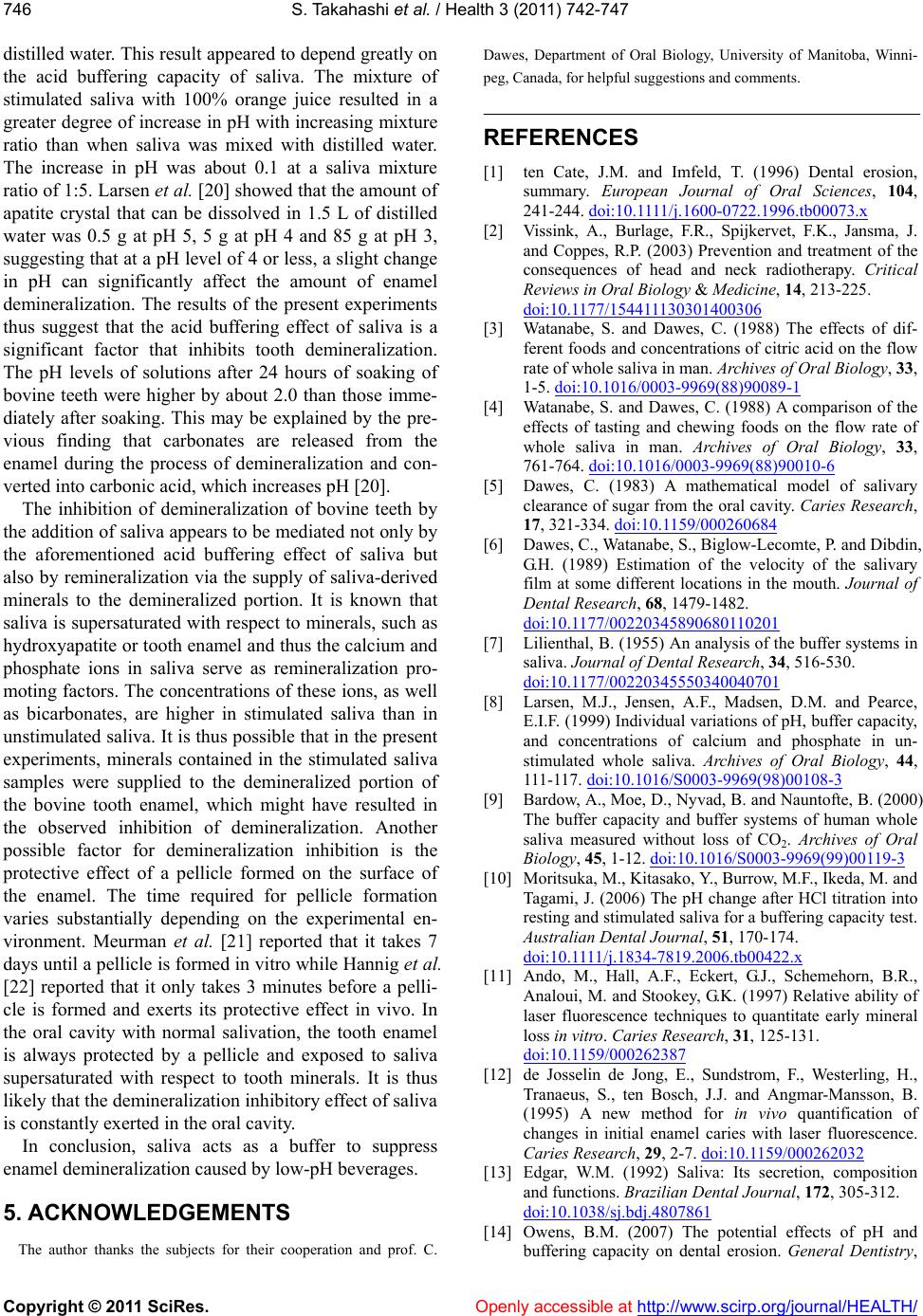
S. Takahashi et al. / Health 3 (2011) 742-747
Copyright © 2011 SciRes. Openly accessible at http:// www.scirp.org/journal/HEALTH/
746
distilled water. This result appeared to depend greatly on
the acid buffering capacity of saliva. The mixture of
stimulated saliva with 100% orange juice resulted in a
greater degree of increase in pH with increasing mixture
ratio than when saliva was mixed with distilled water.
The increase in pH was about 0.1 at a saliva mixture
ratio of 1:5. Larsen et al. [20] showed that the amount of
apatite crystal that can be dissolved in 1.5 L of distilled
water was 0.5 g at pH 5, 5 g at pH 4 and 85 g at pH 3,
suggesting that at a pH level of 4 or less, a slight change
in pH can significantly affect the amount of enamel
demineralization. The results of the present experiments
thus suggest that the acid buffering effect of saliva is a
significant factor that inhibits tooth demineralization.
The pH levels of solutions after 24 hours of soaking of
bovine teeth were higher by about 2.0 than those imme-
diately after soaking. This may be explained by the pre-
vious finding that carbonates are released from the
enamel during the process of demineralization and con-
verted into carbonic acid, which increases pH [20].
The inhibition of demineralization of bovine teeth by
the addition of saliva appears to be mediated not only by
the aforementioned acid buffering effect of saliva but
also by remineralization via the supply of saliva-derived
minerals to the demineralized portion. It is known that
saliva is supersaturated with respect to minerals, such as
hydroxyapatite or tooth enamel and thus the calcium and
phosphate ions in saliva serve as remineralization pro-
moting factors. The concentrations of these ions, as well
as bicarbonates, are higher in stimulated saliva than in
unstimulated saliva. It is thus possible that in the present
experiments, minerals contained in the stimulated saliva
samples were supplied to the demineralized portion of
the bovine tooth enamel, which might have resulted in
the observed inhibition of demineralization. Another
possible factor for demineralization inhibition is the
protective effect of a pellicle formed on the surface of
the enamel. The time required for pellicle formation
varies substantially depending on the experimental en-
vironment. Meurman et al. [21] reported that it takes 7
days until a pellicle is formed in vitro while Hannig et al.
[22] reported that it only takes 3 minutes before a pelli-
cle is formed and exerts its protective effect in vivo. In
the oral cavity with normal salivation, the tooth enamel
is always protected by a pellicle and exposed to saliva
supersaturated with respect to tooth minerals. It is thus
likely that the demineralization inhibitory effect of saliva
is constantly exerted in the oral cavity.
In conclusion, saliva acts as a buffer to suppress
enamel demineralization caused by low-pH beverages.
5. ACKNOWLEDGEMENTS
The author thanks the subjects for their cooperation and prof. C.
Dawes, Department of Oral Biology, University of Manitoba, Winni-
peg, Canada, for helpful suggestions and comments.
REFERENCES
[1] ten Cate, J.M. and Imfeld, T. (1996) Dental erosion,
summary. European Journal of Oral Sciences, 104,
241-244. doi:10.1111/j.1600-0722.1996.tb00073.x
[2] Vissink, A., Burlage, F.R., Spijkervet, F.K., Jansma, J.
and Coppes, R.P. (2003) Prevention and treatment of the
consequences of head and neck radiotherapy. Critical
Reviews in Oral Biology & Medicine, 14, 213-225.
doi:10.1177/154411130301400306
[3] Watanabe, S. and Dawes, C. (1988) The effects of dif-
ferent foods and concentrations of citric acid on the flow
rate of whole saliva in man. Archives of Oral Biology, 33,
1-5. doi:10.1016/0003-9969(88)90089-1
[4] Watanabe, S. and Dawes, C. (1988) A comparison of the
effects of tasting and chewing foods on the flow rate of
whole saliva in man. Archives of Oral Biology, 33,
761-764. doi:10.1016/0003-9969(88)90010-6
[5] Dawes, C. (1983) A mathematical model of salivary
clearance of sugar from the oral cavity. Caries Research,
17, 321-334. doi:10.1159/000260684
[6] Dawes, C., Watanabe, S., Biglow-Lecomte, P. and Dibdin,
G.H. (1989) Estimation of the velocity of the salivary
film at some different locations in the mouth. Journal of
Dental Research, 68, 1479-1482.
doi:10.1177/00220345890680110201
[7] Lilienthal, B. (1955) An analysis of the buffer systems in
saliva. Journal of Dental Research, 34, 516-530.
doi:10.1177/00220345550340040701
[8] Larsen, M.J., Jensen, A.F., Madsen, D.M. and Pearce,
E.I.F. (1999) Individual variations of pH, buffer capacity,
and concentrations of calcium and phosphate in un-
stimulated whole saliva. Archives of Oral Biology, 44,
111-117. doi:10.1016/S0003-9969(98)00108-3
[9] Bardow, A., Moe, D., Nyvad, B. and Nauntofte, B. (2000)
The buffer capacity and buffer systems of human whole
saliva measured without loss of CO2. Archives of Oral
Biology, 45, 1-12. doi:10.1016/S0003-9969(99)00119-3
[10] Moritsuka, M., Kitasako, Y., Burrow, M.F., Ikeda, M. and
Tagami, J. (2006) The pH change after HCl titration into
resting and stimulated saliva for a buffering capacity test.
Australian Dental Journal, 51, 170-174.
doi:10.1111/j.1834-7819.2006.tb00422.x
[11] Ando, M., Hall, A.F., Eckert, G.J., Schemehorn, B.R.,
Analoui, M. and Stookey, G.K. (1997) Relative ability of
laser fluorescence techniques to quantitate early mineral
loss in vitro. Caries Research, 31, 125-131.
doi:10.1159/000262387
[12] de Josselin de Jong, E., Sundstrom, F., Westerling, H.,
Tranaeus, S., ten Bosch, J.J. and Angmar-Mansson, B.
(1995) A new method for in vivo quantification of
changes in initial enamel caries with laser fluorescence.
Caries Research, 29, 2-7. doi:10.1159/000262032
[13] Edgar, W.M. (1992) Saliva: Its secretion, composition
and functions. Brazilian Dental Journal, 172, 305-312.
doi:10.1038/sj.bdj.4807861
[14] Owens, B.M. (2007) The potential effects of pH and
buffering capacity on dental erosion. General Dentistry,